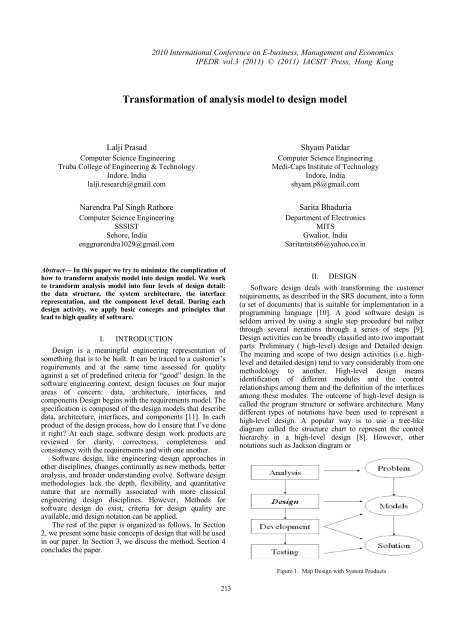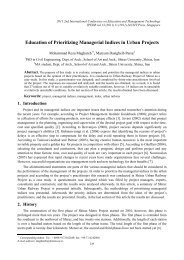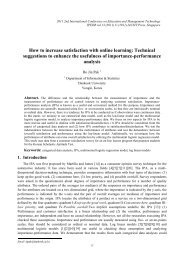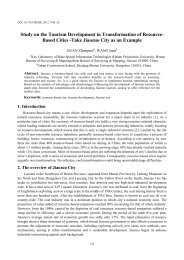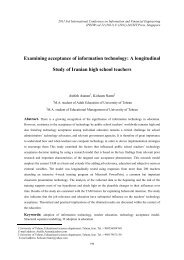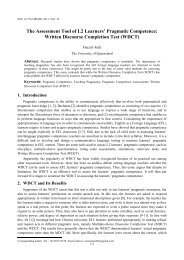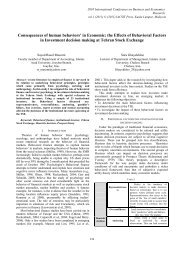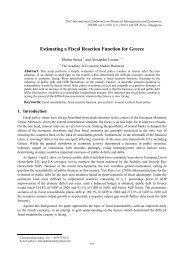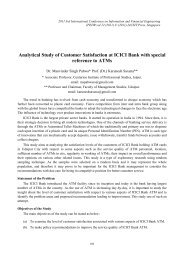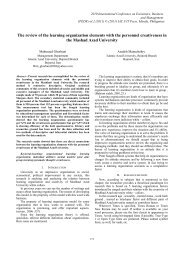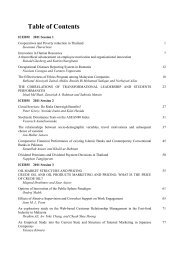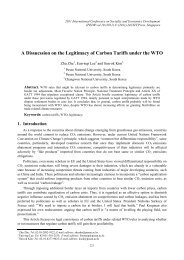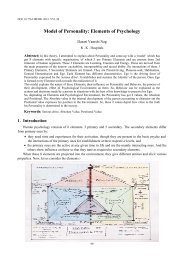Transformation of analysis model to design model - ResearchGate
Transformation of analysis model to design model - ResearchGate
Transformation of analysis model to design model - ResearchGate
Create successful ePaper yourself
Turn your PDF publications into a flip-book with our unique Google optimized e-Paper software.
2010 International Conference on E-business, Management and Economics<br />
IPEDR vol.3 (2011) © (2011) IACSIT Press, Hong Kong<br />
<strong>Transformation</strong> <strong>of</strong> <strong>analysis</strong> <strong>model</strong> <strong>to</strong> <strong>design</strong> <strong>model</strong><br />
Lalji Prasad<br />
Computer Science Engineering<br />
Truba College <strong>of</strong> Engineering & Technology<br />
Indore, India<br />
lalji.research@gmail.com<br />
Shyam Patidar<br />
Computer Science Engineering<br />
Medi-Caps Institute <strong>of</strong> Technology<br />
Indore, India<br />
shyam.p8@gmail.com<br />
Narendra Pal Singh Rathore<br />
Computer Science Engineering<br />
SSSIST<br />
Sehore, India<br />
enggnarendra1029@gmail.com<br />
Sarita Bhaduria<br />
Department <strong>of</strong> Electronics<br />
MITS<br />
Gwalior, India<br />
Saritamits66@yahoo.co.in<br />
Abstract— In this paper we try <strong>to</strong> minimize the complication <strong>of</strong><br />
how <strong>to</strong> transform <strong>analysis</strong> <strong>model</strong> in<strong>to</strong> <strong>design</strong> <strong>model</strong>. We work<br />
<strong>to</strong> transform <strong>analysis</strong> <strong>model</strong> in<strong>to</strong> four levels <strong>of</strong> <strong>design</strong> detail:<br />
the data structure, the system architecture, the interface<br />
representation, and the component level detail. During each<br />
<strong>design</strong> activity, we apply basic concepts and principles that<br />
lead <strong>to</strong> high quality <strong>of</strong> s<strong>of</strong>tware.<br />
I. INTRODUCTION<br />
Design is a meaningful engineering representation <strong>of</strong><br />
something that is <strong>to</strong> be built. It can be traced <strong>to</strong> a cus<strong>to</strong>mer’s<br />
requirements and at the same time assessed for quality<br />
against a set <strong>of</strong> predefined criteria for ―good‖ <strong>design</strong>. In the<br />
s<strong>of</strong>tware engineering context, <strong>design</strong> focuses on four major<br />
areas <strong>of</strong> concern: data, architecture, interfaces, and<br />
components Design begins with the requirements <strong>model</strong>. The<br />
specification is composed <strong>of</strong> the <strong>design</strong> <strong>model</strong>s that describe<br />
data, architecture, interfaces, and components [11]. In each<br />
product <strong>of</strong> the <strong>design</strong> process, how do I ensure that I’ve done<br />
it right? At each stage, s<strong>of</strong>tware <strong>design</strong> work products are<br />
reviewed for clarity, correctness, completeness and<br />
consistency with the requirements and with one another.<br />
S<strong>of</strong>tware <strong>design</strong>, like engineering <strong>design</strong> approaches in<br />
other disciplines, changes continually as new methods, better<br />
<strong>analysis</strong>, and broader understanding evolve. S<strong>of</strong>tware <strong>design</strong><br />
methodologies lack the depth, flexibility, and quantitative<br />
nature that are normally associated with more classical<br />
engineering <strong>design</strong> disciplines. However, Methods for<br />
s<strong>of</strong>tware <strong>design</strong> do exist, criteria for <strong>design</strong> quality are<br />
available, and <strong>design</strong> notation can be applied.<br />
The rest <strong>of</strong> the paper is organized as follows. In Section<br />
2, we present some basic concepts <strong>of</strong> <strong>design</strong> that will be used<br />
in our paper. In Section 3, we discuss the method. Section 4<br />
concludes the paper.<br />
II.<br />
DESIGN<br />
S<strong>of</strong>tware <strong>design</strong> deals with transforming the cus<strong>to</strong>mer<br />
requirements, as described in the SRS document, in<strong>to</strong> a form<br />
(a set <strong>of</strong> documents) that is suitable for implementation in a<br />
programming language [10]. A good s<strong>of</strong>tware <strong>design</strong> is<br />
seldom arrived by using a single step procedure but rather<br />
through several iterations through a series <strong>of</strong> steps [9].<br />
Design activities can be broadly classified in<strong>to</strong> two important<br />
parts: Preliminary ( high-level) <strong>design</strong> and Detailed <strong>design</strong>.<br />
The meaning and scope <strong>of</strong> two <strong>design</strong> activities (i.e. highlevel<br />
and detailed <strong>design</strong>) tend <strong>to</strong> vary considerably from one<br />
methodology <strong>to</strong> another. High-level <strong>design</strong> means<br />
identification <strong>of</strong> different modules and the control<br />
relationships among them and the definition <strong>of</strong> the interfaces<br />
among these modules. The outcome <strong>of</strong> high-level <strong>design</strong> is<br />
called the program structure or s<strong>of</strong>tware architecture. Many<br />
different types <strong>of</strong> notations have been used <strong>to</strong> represent a<br />
high-level <strong>design</strong>. A popular way is <strong>to</strong> use a tree-like<br />
diagram called the structure chart <strong>to</strong> represent the control<br />
hierarchy in a high-level <strong>design</strong> [8]. However, other<br />
notations such as Jackson diagram or<br />
Figure 1. Map Design with System Products<br />
213
Warnier-Orr [11] diagram can also be used. During<br />
detailed <strong>design</strong>, the data structure and the algorithms <strong>of</strong> the<br />
different modules are <strong>design</strong>ed.<br />
Implementation<br />
Environment<br />
(Language)<br />
Presentation<br />
Behavior<br />
Information<br />
Figure 2. A Design <strong>model</strong> with a new dimension.<br />
A. Design Model<br />
The <strong>analysis</strong> <strong>model</strong> is refined and formalized <strong>to</strong> get a<br />
<strong>design</strong> <strong>model</strong>. During <strong>design</strong> <strong>model</strong>ing, we try <strong>to</strong> adapt <strong>to</strong><br />
the actual implementation environment. In <strong>design</strong> space, yet<br />
another new dimension has been added <strong>to</strong> the <strong>analysis</strong> space<br />
<strong>to</strong> include the implementation environment. This is show in<br />
fig. 2. This means that we want <strong>to</strong> adopt our <strong>analysis</strong> <strong>model</strong><br />
<strong>to</strong> fit in the implementation <strong>model</strong> at the same time as we<br />
refine it. But changes cannot be avoided so, we develop a<br />
new <strong>model</strong>.<br />
III.<br />
METHOD<br />
S<strong>of</strong>tware <strong>design</strong> sits at the technical kernel <strong>of</strong> s<strong>of</strong>tware<br />
engineering and is applied regardless <strong>of</strong> the s<strong>of</strong>tware<br />
process <strong>model</strong> that is used [9]. Beginning once s<strong>of</strong>tware<br />
requirements have been analyzed and specified, s<strong>of</strong>tware<br />
<strong>design</strong> is the first <strong>of</strong> three technical activities—<strong>design</strong>, code<br />
generation, and test—that are required <strong>to</strong> build and verify<br />
the s<strong>of</strong>tware. Each activity transforms information in a<br />
manner that ultimately results in validated computer<br />
s<strong>of</strong>tware. Each <strong>of</strong> the elements <strong>of</strong> the <strong>analysis</strong> <strong>model</strong><br />
provides information that is necessary <strong>to</strong> create the four<br />
<strong>design</strong> <strong>model</strong>s required for a complete specification <strong>of</strong><br />
<strong>design</strong>. The flow <strong>of</strong> information during s<strong>of</strong>tware <strong>design</strong> is<br />
illustrated in Figure 3. S<strong>of</strong>tware requirements, manifested<br />
by the data, functional, and behavioral <strong>model</strong>s, feed the<br />
<strong>design</strong> task. Using one the <strong>design</strong> methods. The <strong>design</strong> task<br />
produces a data <strong>design</strong>, an architectural <strong>design</strong>, an interface<br />
<strong>design</strong>, and a component <strong>design</strong> [6]. The data <strong>design</strong><br />
transforms the information domain <strong>model</strong> created during<br />
<strong>analysis</strong> in<strong>to</strong> the data structures that will be required <strong>to</strong><br />
implement the s<strong>of</strong>tware.<br />
The data objects and relationships defined in the entity<br />
relationship diagram and the detailed data content depicted<br />
in the data dictionary provide the basis for the data <strong>design</strong><br />
activity [6]. Part <strong>of</strong> data <strong>design</strong> may occur in conjunction<br />
with the <strong>design</strong> <strong>of</strong> s<strong>of</strong>tware architecture. More detailed data<br />
<strong>design</strong> occurs as each s<strong>of</strong>tware component is <strong>design</strong>ed.<br />
The architectural <strong>design</strong> defines the relationship between<br />
major structural elements <strong>of</strong> the s<strong>of</strong>tware, the ―<strong>design</strong><br />
patterns‖ that can be used <strong>to</strong> achieve the requirements that<br />
have been defined for the system, and the constraints that<br />
affect the way in which architectural <strong>design</strong> patterns can be<br />
applied [8]. The architectural <strong>design</strong> representation—the<br />
framework <strong>of</strong> a computer-based system—can be derived<br />
from the system specification, the <strong>analysis</strong> <strong>model</strong>, and the<br />
interaction <strong>of</strong> subsystems defined within the <strong>analysis</strong> <strong>model</strong>.<br />
The interface <strong>design</strong> describes how the s<strong>of</strong>tware<br />
communicates within itself, with systems that interoperate<br />
with it, and with humans who use it. An interface implies a<br />
flow <strong>of</strong> information (e.g., data and/or control) and a specific<br />
type <strong>of</strong> behavior. Therefore, data and control flow diagrams<br />
provide much <strong>of</strong> the information required for interface<br />
<strong>design</strong>.<br />
The importance <strong>of</strong> s<strong>of</strong>tware <strong>design</strong> can be stated with a<br />
single word—quality [9]. Design is the place where quality<br />
is fostered in s<strong>of</strong>tware engineering. Design provides us with<br />
representations <strong>of</strong> s<strong>of</strong>tware that can be assessed for quality.<br />
Design is the only way that we can accurately translate a<br />
cus<strong>to</strong>mer's requirements in<strong>to</strong> a quality s<strong>of</strong>tware product or<br />
system. S<strong>of</strong>tware <strong>design</strong> serves as the foundation for all the<br />
s<strong>of</strong>tware engineering and s<strong>of</strong>tware support steps that follow.<br />
Without <strong>design</strong>, we risk building an unstable system—one<br />
that will fail when small changes are made; one that may be<br />
difficult <strong>to</strong> test; one whose quality cannot be assessed until<br />
late in the s<strong>of</strong>tware process, when time is short and many<br />
dollars have already been spent. Explaining the idea/concept<br />
<strong>of</strong> something usually with graphical diagrams with the<br />
intention <strong>to</strong> build from the explanation. The <strong>design</strong> is a<br />
representation <strong>of</strong> a product or a system with sufficient detail<br />
for implementation. From our understanding <strong>of</strong> the problem,<br />
we start building the s<strong>of</strong>tware. Translate the <strong>analysis</strong> <strong>model</strong><br />
in<strong>to</strong> the <strong>design</strong> <strong>model</strong>. Map the information from the<br />
<strong>analysis</strong> <strong>model</strong> <strong>to</strong> the <strong>design</strong> representations - data <strong>design</strong>,<br />
architectural <strong>design</strong>, interface <strong>design</strong>, procedural <strong>design</strong>.<br />
A. The <strong>design</strong> process should not suffer from tunnel vision<br />
A good <strong>design</strong>er should consider alternative approaches,<br />
judging each based on the requirements <strong>of</strong> the problem, the<br />
resources available <strong>to</strong> do the job [11].<br />
B. The <strong>design</strong> should be traceable <strong>to</strong> the <strong>analysis</strong> <strong>model</strong><br />
Because a single element <strong>of</strong> the <strong>design</strong> <strong>model</strong> <strong>of</strong>ten<br />
traces <strong>to</strong> multiple requirements, it is necessary <strong>to</strong> have a<br />
means for tracking how requirements have been satisfied by<br />
the <strong>design</strong> <strong>model</strong>.<br />
C. The <strong>design</strong> should minimize the intellectual distance<br />
between the s<strong>of</strong>tware and the problem as it exists in the<br />
real world.<br />
That is, the structure <strong>of</strong> the s<strong>of</strong>tware <strong>design</strong> should<br />
(whenever possible) mimic the structure <strong>of</strong> the problem<br />
domain.<br />
214
Figure 3. Translating the <strong>analysis</strong> <strong>model</strong> in<strong>to</strong> a s<strong>of</strong>tware <strong>design</strong><br />
D. The <strong>design</strong> should exhibit uniformity and integration<br />
A <strong>design</strong> is uniform if it appears that one person<br />
developed the entire thing. Rules <strong>of</strong> style and format should<br />
be defined for a <strong>design</strong> team before <strong>design</strong> work begins. A<br />
<strong>design</strong> is integrated if care is taken in defining interfaces<br />
between <strong>design</strong> components.<br />
E. Design is not coding, coding is not <strong>design</strong><br />
Even when detailed procedural <strong>design</strong>s are created for<br />
program components, the level <strong>of</strong> abstraction <strong>of</strong> the <strong>design</strong><br />
<strong>model</strong> is higher than source code. The only <strong>design</strong> decisions<br />
made at the coding level address the small implementation<br />
details that enable the procedural <strong>design</strong> <strong>to</strong> be coded.<br />
F. The <strong>design</strong> should be assessed for quality<br />
A variety <strong>of</strong> <strong>design</strong> concepts and <strong>design</strong> measures are<br />
available <strong>to</strong> assist the <strong>design</strong>er in assessing quality.<br />
G. The <strong>design</strong> should be reviewed <strong>to</strong> minimize conceptual<br />
errors<br />
There is sometimes a tendency <strong>to</strong> focus on minutiae<br />
when the <strong>design</strong> is reviewed, missing the forest for the trees.<br />
A <strong>design</strong> team should ensure that major conceptual elements<br />
<strong>of</strong> the <strong>design</strong> (omissions, ambiguity, and inconsistency)<br />
have been addressed before worrying about the syntax <strong>of</strong> the<br />
<strong>design</strong> <strong>model</strong>.<br />
In the construction process, we construct the system<br />
using both the <strong>analysis</strong> <strong>model</strong> and requirements <strong>model</strong>. We<br />
<strong>design</strong> and implement the system. Firstly, a <strong>design</strong> <strong>model</strong> is<br />
made where each object will be fully specified. This <strong>model</strong><br />
will then form an input data for the rest process.<br />
H. When <strong>to</strong> do this transition?<br />
The transition from the <strong>analysis</strong> <strong>model</strong> <strong>to</strong> the <strong>design</strong><br />
<strong>model</strong> should be made when the Consequences <strong>of</strong> the<br />
implementation environment start <strong>to</strong> show. This is shown in<br />
fig. 5 with adaptation <strong>of</strong> DBMS distributed environment,<br />
real-time adaptations etc. then it is fine <strong>to</strong> be quite formal in<br />
the <strong>analysis</strong> <strong>model</strong>.<br />
But if these circumstances will strongly affect the<br />
system structure, then the transition should be made quite<br />
early. The goal is not <strong>to</strong> redo any work in a later phase that<br />
has done in an earlier phase. We try <strong>to</strong> keep an ideal<br />
<strong>analysis</strong> <strong>model</strong> <strong>of</strong> a system during the entire system life<br />
cycle.<br />
A <strong>design</strong> <strong>model</strong> is a Specialization <strong>of</strong> the <strong>analysis</strong> <strong>model</strong><br />
for a specific implementation environment [1]. Such<br />
changes are then easily incorporated because it is the same<br />
<strong>analysis</strong> <strong>model</strong> that will form should not affect the <strong>analysis</strong><br />
<strong>model</strong> as we do not want changes due <strong>to</strong> <strong>design</strong> decisions <strong>to</strong><br />
be illustrated in the <strong>analysis</strong> <strong>model</strong> at fig 3.<br />
215
Figure 4. Dimensions <strong>of</strong> the <strong>design</strong> <strong>model</strong><br />
I. When Changes should be made?<br />
If a change <strong>of</strong> the <strong>design</strong> <strong>model</strong> comes from a logical<br />
change in the system, then such changes should also be<br />
made in the <strong>analysis</strong> <strong>model</strong>.<br />
We use a concept <strong>of</strong> block now <strong>to</strong> describe the intention<br />
<strong>of</strong> how the code should be produced. The blocks are the<br />
<strong>design</strong> objects. One block normally tries <strong>to</strong> implement<br />
should not affect the <strong>analysis</strong> <strong>model</strong> as we do not want<br />
changes due <strong>to</strong> <strong>design</strong> decisions <strong>to</strong> be illustrated in the<br />
<strong>analysis</strong> <strong>model</strong> at fig 2.<br />
IV.<br />
CONCLUSION<br />
Design is the technical kernel <strong>of</strong> s<strong>of</strong>tware engineering.<br />
During <strong>design</strong>, progressive refinements <strong>of</strong> data structure,<br />
architecture, interfaces, and procedural detail <strong>of</strong> s<strong>of</strong>tware<br />
components are developed, reviewed, and documented.<br />
216
Analysis Model Design Model<br />
that conforms <strong>to</strong> fundamental concepts that lead <strong>to</strong> high<br />
quality s<strong>of</strong>tware. We try <strong>to</strong> solve the problem by rushing<br />
through the <strong>design</strong> process so that enough time will be left<br />
at the end <strong>of</strong> the project <strong>to</strong> uncover errors that were made<br />
because we rushed through the <strong>design</strong> process.<br />
Refinement<br />
When consequences <strong>of</strong> implantation environment Start <strong>to</strong> show<br />
Figure 5. Transition<br />
Design results in representations <strong>of</strong> s<strong>of</strong>tware that can be<br />
assessed for quality. A number <strong>of</strong> fundamental s<strong>of</strong>tware<br />
<strong>design</strong> principles and concepts have been proposed over the<br />
past four decades. Design principles guide the s<strong>of</strong>tware<br />
engineer as the <strong>design</strong> process proceeds. Design concepts<br />
provide basic criteria for <strong>design</strong> quality. Design<br />
representations are tied <strong>to</strong> the others, and all can be traced<br />
back <strong>to</strong> s<strong>of</strong>tware requirements. It is interesting <strong>to</strong> note that<br />
some programmers continue <strong>to</strong> <strong>design</strong> implicitly,<br />
conducting component-level <strong>design</strong> as they code. This is<br />
akin <strong>to</strong> taking the <strong>design</strong> pyramid and standing it on its<br />
point—an extremely unstable <strong>design</strong> results. The smallest<br />
change may cause the pyramid (and the program) <strong>to</strong> <strong>to</strong>pple.<br />
Each method enables the <strong>design</strong>er <strong>to</strong> create a stable <strong>design</strong><br />
REFERENCES<br />
[1] Asada, T., et al., "The Quantified Design Space," in S<strong>of</strong>tware<br />
Architecture (Shaw, M. and D. Garlan), Prentice-Hall, 1996, pp. 116<br />
–127.<br />
[2] Bass, L., P. Clements, and R. Kazman, S<strong>of</strong>tware Architecture in<br />
Practice, Addison-Wesley, 1998.<br />
[3] Dennis, J.B., "Modularity," in Advanced Course on S<strong>of</strong>tware<br />
Engineering (F.L. Bauer, ed.), Springer-Verlag, 1973, pp. 128–182.<br />
[4] Freeman, P., "The Context <strong>of</strong> Design," in S<strong>of</strong>tware Design<br />
Techniques, 3rd ed.(P. Freeman and A. Wasserman, eds.), IEEE Co<br />
mputer Society Press, 1980, pp. 2 –4.<br />
[5] Kazman, R. et al., The Architectural Trade<strong>of</strong>f Analysis Method,<br />
S<strong>of</strong>tware Engineering Institute, CMU/SEI-98-TR-008, July 1998.<br />
[6] Wasserman, A., "Principles <strong>of</strong> Systematic Data Design and<br />
Implementation," in S<strong>of</strong>tware Design Techniques (P. Freeman<br />
and A Wasserman, ed.), 3rd ed., IEEE Computer Society Press, 1980.<br />
[7] Myers, G., Composite Structured Design, Van Nostrand, 1978.<br />
[8] Somerville, I., S<strong>of</strong>tware Engineering, 3rd ed., Addison-Wesley, 1989.<br />
[9] Belady, L., Foreword <strong>to</strong> S<strong>of</strong>tware Design: Methods and Techniques<br />
(L.J. Peters,author), Yourdon Press, 1981.<br />
[10] Rajib Mall, Fundamentals <strong>of</strong> s<strong>of</strong>tware engineering, 3 rd ed., 2009<br />
[11] Roger S. Pressman, s<strong>of</strong>tware engineering, ―A Practitioner’s<br />
Approach, 5 th ed.<br />
217


